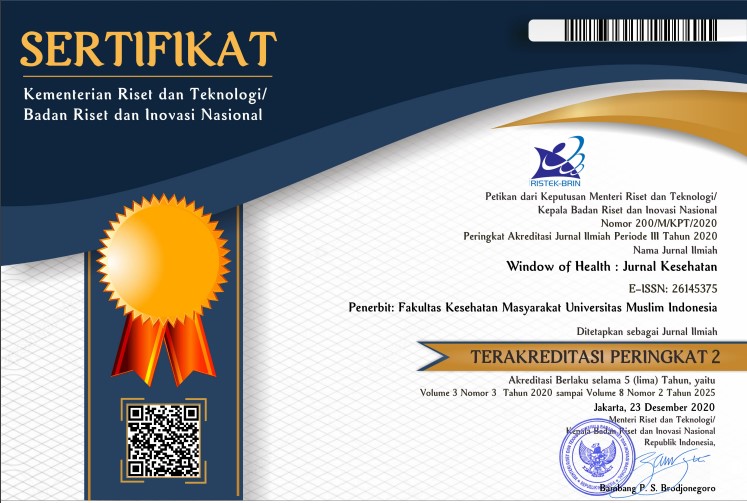Incidence of Stunting: Early and Exclusive Breastfeeding in Two-Year-Old Children
Abstract
The condition of toddlers having less length or height based on age as a result of factors such as socio-economic conditions, maternal nutrition during pregnancy, and lack of nutritional intake in the first 1000 days of life is called stunting. Nutritional intake factors include failure to initiate breastfeeding, failure to provide exclusive breast milk, and the early weaning process. The research aims to determine the relationship between a history of early initiation of breastfeeding and exclusive breastfeeding with the incidence of stunting in children under two years aged 6-24 months. The research was conducted in the work area of the Lere Community Health Center, Palu City. This type of research is observation with a case-control approach with chi-square analysis. The sample in this study was 19 stunted and 38 under two years old who were not stunted. Data is presented in table form accompanied by a narrative. The results of the research showed that from 57 samples, the percentage of stunting was 33.3%, those under two years old who received early initiation of breastfeeding was 47.4%, and those who received exclusive breast milk were 56.1%. The statistical test results show a significant relationship between a history of early and exclusive breastfeeding and the incidence of stunting in toddlers aged 6-24 months (p < 0.05) with an OR of 9.143 and 6.873, respectively. It is recommended that pregnant women initiate early breastfeeding immediately after giving birth and commit to providing exclusive breastfeeding to maintain the child's growth and development.
References
Abeng, A. T. and Mappanganro, A. Penyuluhan Inisiasi Menyusui Dini ( IMD ) pada Ibu Post Partum di RSB Masyita Kota Makassar, Idea Pengabdian Masyarakat; 2020 1(01), pp. 5–9.
Ali, A. H., Adam, A. and Alim, A. Hubungan Inisiasi Menyusui Dini (IMD) terhadap Status Gizi Bayi Dibawah Dua Tahun (BADUTA) di Puskesmas Malaka Kecamatan Lalabata Kabupaten Soppeng, ARTERI : Jurnal Ilmu Kesehatan, 1(1); 2019 pp. 76–84.
Angelina, C., Perdana, A. A. and Humairoh. Faktor Kejadian Stunting Balita Berusia 6-23 Bulan Di Provinsi Lampung, Jurnal Dunia Kesmas, 7; 2019 pp. 127–134.
Anggraini, F. D. and Zulaikha, L. I. Pelaksanaan Inisiasi Menyusu Dini (Imd) Pada Ibu Bersalin Di Pondok Bersalin Kelurahan Kolpajung, Jurnal Sakti Bidadari, V(Imd); 2021.
Annisa, N., Sumiaty and Tondong, H. I. Hubungan Inisiasi Menyusu Dini dan ASI Eksklusif dengan Stunting pada Baduta Usia 7-24 Bulan, Jurnal Bidan Cerdas (JBC); 2019 2(2), p. 92.
Ayun, F. Q., Budiarti, Y. and Astiriyani, E. Hubungan Inisiasi Menyusui Dini (IMD) dengan Keberhasilan Pemberian ASI Eksklusif Pada Ibu Yang Memiliki Bayi Usia 7-12 Bulan Di Puskesmas Tanjungsari Kabupaten Sumedang Tahun 2020, Journal of Midwifery Informastion (JoMI), 2(1); 2021 pp. 114–127.
Cobalt, M., Anggorowati and Nurrahima, A. Manajemen Laktasi dan Positive Self Talk, Magister Keperawatan Universitas Diponegoro; 2018 pp. 1–44.
Fitri, L. Hubungan BBLR dan ASI Ekslusif dengan Kejadian Stunting Di Puskesmas Lima Puluh Pekanbaru, Jurnal Endurance; 2018 3(1), p. 131.
Husnayain, Z. S. et al. The Relationship Between The Level of Mother’s Breastfeeding Knowledge With Exclusive Breastfeeding Practice in The Center of Public Health Kenjeran, MAGNA MEDICA; 2021 8(1), p. 1.
Kemenkes RI. Buletin Jendela Data dan Informasi Kesehatan tentang Stunting, Pusat Data dan Informasi Kesehatan; 2018 301(5).
Kemenkes RI. PERMENKES tentang Standar Antropometri Anak, 2020 (3); 2020 pp. 151–156.
Kemenkes RI. Situasi Stunting di Indonesia, Pusat Data dan Informasi Kesehatan; 2020b.
Kemenkes RI. Buku Saku Hasil Studi Status Gizi Indonesia (SSGI) Tingkat Nasional, Provinsi, dan Kabupaten/Kota tahun 2021; 2021.
Litbangkes. Kemenkes RI. Buku Saku Hasil Studi Status Gizi Indonesia (SSGI) Tingkat Nasional, Provinsi, dan Kabupaten/Kota tahun 2022, Kemenkes; 2022.
Kementerian PPN/ Bappenas. Pedoman Pelaksanaan Intervensi Penurunan Stunting Terintegrasi di Kabupaten/Kota, Kementrian PPN/Bappenas; 2018.
Kristanti, I., Herawati, C. and Susilawati, D. Kontribusi Faktor Internal dan Eksternal Determinan Perilaku Terhadap Pemberian ASI Ekslusif Pada Bayi Baru Lahir, Dimasejati: Jurnal Pengabdian Kepada Masyarakat, 1(2); 2019 pp. 245–257.
Meiandari, G. R. U. Hubungan Dukungan Keluarga Terhadap Pemberian ASI Ekslusif Pada ibu Menyususi Di Desa Pohsanten kecamatan Mendoyo Kabupaten Jembrana, Poltekkes Denpasar, 53(9); 2020 pp. 1689–1699.
Ningsih, M. Keajaiban Inisiasi Menyusu Dini (IMD), Jurnal Ilmiah Sangkareang Mataram, 8(Imd); 2019 pp. 1–15.
Pertiwi, I. A., Aritonang, I. and Wijanarka, A. Kajian Pengetahuan Ibu tentang MP-ASI dan Pemberian MP-ASI pada Anak 6-24 Bulan Penderita Stunting di Desa Trimurti Kecamatan Srandakan; 2019.
Poltekkes Kemenkes Yogyakarta. Kuesioner Individu Riskesdas 2018, Badan Penelitian dan Pengembangan Kesehatan; 2018 (2), p. 24
Rismawati and Ohorella, F. Pentingnya Iniasiasi Menyusu Dini (IMD) Pada Bayi Baru Lahir, Jurnal Pengabdian Kepada Masyarakat, 1(1); 2021 pp. 21–25.
Sabilla, P. N., Widyasih, H. and Muslihatun, W. N. Gambaran Karakteristik Dan Pemberian Asi Eksklusif Pada Ibu Bekerja Di Posyandu Kunci Vi, Viii B, Dan Xiii Kelurahan Pandeyan Umbulharjo Kota Yogyakarta, Poltekkes Kemenkes Yogyakarta; 2020 pp. 103–111.
Saryaman, R. and Girsang, E. Proses Laktasi & Menyusui. STIkes Wijaya Husada Bogor; 2020.
Sunartiningsih, S., Fatoni, I. and Ningrum, N. M. Hubungan Inisiasi Menyusu Dini Dengan Kejadian Stunting Pada Balita Usia 12-24 Bulan, Jurnal Kebidanan, 10(2), 2021; pp. 66–79.
Suprayoga, H.Capaian, Tantangan dan Peluang Pelaksanaan Strategi Nasional Percepatan Pencegahan Stunting Tahun 2018- 2024; 2021 pp. 1–24.
TNP2K. 1001 Kabupaten/Kota Prioritas untuk Intervensi Anak Kerdil (Stunting), Sekretariat Wakil Presiden RI; 2020.
UNICEF, WHO and World Bank. Levels and Trends in Child Malnutrition, Geneva: WHO ; 2020.
Windasari, D. P., Syam, I. and Kamal, L. S. Faktor Hubungan dengan Kejadian Stunting di Puskesmas Tamalate Kota Makassar, AcTion: Aceh Nutrition Journal, 5(1). 2020; p. 27.
Yuliawati, E., Sulung, N. and Hasnita, E. Inisiasi Menyusui Dini, Keanekaragaman Makanan dan Jaminan Kesehatan Terhadap Kejadian Stunting, Jurnal Human Care, 4(3). 2019; pp. 132–137.
Copyright (c) 2024 Rudy Hartono, Yuridesi Nurani Putri Putri, Sunarto Sunarto, Sirajuddin Sirajuddin, Aswita Amir, Muhammad Ikhtiar Muhammad Ikhtiar, Ronny Horax

This work is licensed under a Creative Commons Attribution-NonCommercial-ShareAlike 4.0 International License.








